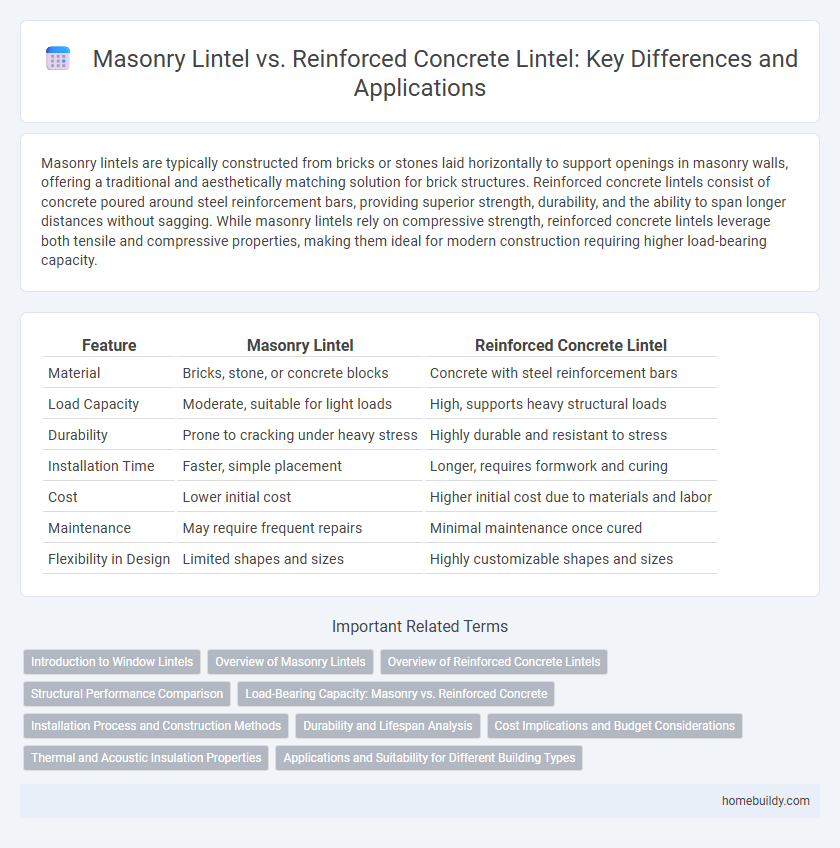Masonry lintels are typically constructed from bricks or stones laid horizontally to support openings in masonry walls, offering a traditional and aesthetically matching solution for brick structures. Reinforced concrete lintels consist of concrete poured around steel reinforcement bars, providing superior strength, durability, and the ability to span longer distances without sagging. While masonry lintels rely on compressive strength, reinforced concrete lintels leverage both tensile and compressive properties, making them ideal for modern construction requiring higher load-bearing capacity.
Table of Comparison
| Feature | Masonry Lintel | Reinforced Concrete Lintel |
|---|---|---|
| Material | Bricks, stone, or concrete blocks | Concrete with steel reinforcement bars |
| Load Capacity | Moderate, suitable for light loads | High, supports heavy structural loads |
| Durability | Prone to cracking under heavy stress | Highly durable and resistant to stress |
| Installation Time | Faster, simple placement | Longer, requires formwork and curing |
| Cost | Lower initial cost | Higher initial cost due to materials and labor |
| Maintenance | May require frequent repairs | Minimal maintenance once cured |
| Flexibility in Design | Limited shapes and sizes | Highly customizable shapes and sizes |
Introduction to Window Lintels
Window lintels serve as horizontal supports above openings in masonry walls, distributing the load to prevent structural failure. Masonry lintels rely on stacked bricks or stones bonded with mortar, offering traditional aesthetics but limited tensile strength and span capacity. Reinforced concrete lintels integrate steel reinforcement within concrete, providing superior strength, durability, and the ability to span wider openings without sagging or cracking.
Overview of Masonry Lintels
Masonry lintels are structural horizontal supports made from brick, stone, or concrete blocks, designed to bear the load above window openings in walls. These lintels rely on the compressive strength of masonry materials and require precise mortar bonding to ensure stability and durability. Compared to reinforced concrete lintels, masonry lintels have limitations in spanning larger openings and resisting tensile stresses, often necessitating additional support for heavy loads.
Overview of Reinforced Concrete Lintels
Reinforced concrete lintels combine steel reinforcement bars and high-strength concrete to provide superior load-bearing capacity and durability compared to traditional masonry lintels. These lintels efficiently support wall loads over window openings while resisting bending and shear stresses, making them ideal for modern construction. The integration of steel reinforcement enhances tensile strength, reducing the risk of cracking and structural failure.
Structural Performance Comparison
Masonry lintels provide adequate structural support for small openings and load-bearing walls but exhibit lower tensile strength and limited resistance to bending compared to reinforced concrete lintels. Reinforced concrete lintels combine the compressive capacity of concrete with steel reinforcement, enabling superior load-bearing capacity, higher durability, and enhanced resistance to cracking and deformation under heavier loads. This makes reinforced concrete lintels preferable for larger spans and critical structural applications where safety and longevity are paramount.
Load-Bearing Capacity: Masonry vs. Reinforced Concrete
Masonry lintels, typically constructed from brick or stone, offer moderate load-bearing capacity suitable for lightweight wall openings but are limited by their tensile strength and prone to cracking under heavy loads. Reinforced concrete lintels incorporate steel reinforcement, significantly enhancing tensile strength and allowing for higher load-bearing capacity, making them ideal for wider spans and structural stability in modern construction. Engineering design favors reinforced concrete lintels for critical applications where durability and load distribution are paramount.
Installation Process and Construction Methods
Masonry lintels are installed by stacking and bonding bricks or stones with mortar over the window opening, requiring careful alignment and curing time for structural integrity. Reinforced concrete lintels involve casting concrete with embedded steel reinforcements, typically using formwork and precise placement of rebar to ensure load-bearing capacity. The construction method for reinforced concrete lintels allows for faster installation and greater uniformity compared to the labor-intensive and time-dependent masonry lintel process.
Durability and Lifespan Analysis
Masonry lintels, typically made from bricks or stone, exhibit natural durability but are susceptible to weathering and cracking over time, limiting their lifespan to around 20-30 years in harsh environments. Reinforced concrete lintels incorporate steel rebars, significantly enhancing tensile strength and resistance to environmental stressors, thereby extending their lifespan well beyond 50 years with proper maintenance. The integration of reinforcement in concrete lintels offers superior durability under dynamic loads and reduces maintenance costs compared to traditional masonry lintels.
Cost Implications and Budget Considerations
Masonry lintels typically offer lower upfront costs due to the use of readily available materials like bricks or stones, making them budget-friendly for small-scale projects. Reinforced concrete lintels, while more expensive initially due to materials and labor, provide enhanced structural strength and durability, potentially reducing long-term maintenance expenses. Choosing between masonry and reinforced concrete lintels requires careful budget analysis balancing immediate cost savings against future performance and maintenance outlays.
Thermal and Acoustic Insulation Properties
Masonry lintels typically offer better thermal insulation due to the natural insulating properties of bricks and stone, reducing heat transfer through window openings. Reinforced concrete lintels provide superior structural strength but often require additional insulation layers to enhance thermal performance and prevent heat loss. Acoustic insulation in masonry lintels benefits from dense material mass, effectively dampening sound transmission, whereas reinforced concrete lintels may need supplementary soundproofing materials for optimal noise reduction.
Applications and Suitability for Different Building Types
Masonry lintels, typically constructed from brick or stone, are well-suited for traditional residential buildings and low-rise structures due to their natural aesthetic and ease of integration with masonry walls. Reinforced concrete lintels offer superior strength and durability, making them ideal for commercial buildings, industrial facilities, and multi-story constructions requiring longer spans and higher load-bearing capacity. Their versatility allows reinforced concrete lintels to accommodate various architectural designs and heavy structural demands, whereas masonry lintels excel in applications prioritizing aesthetic harmony and historical preservation.
masonry lintel vs reinforced concrete lintel Infographic

 homebuildy.com
homebuildy.com